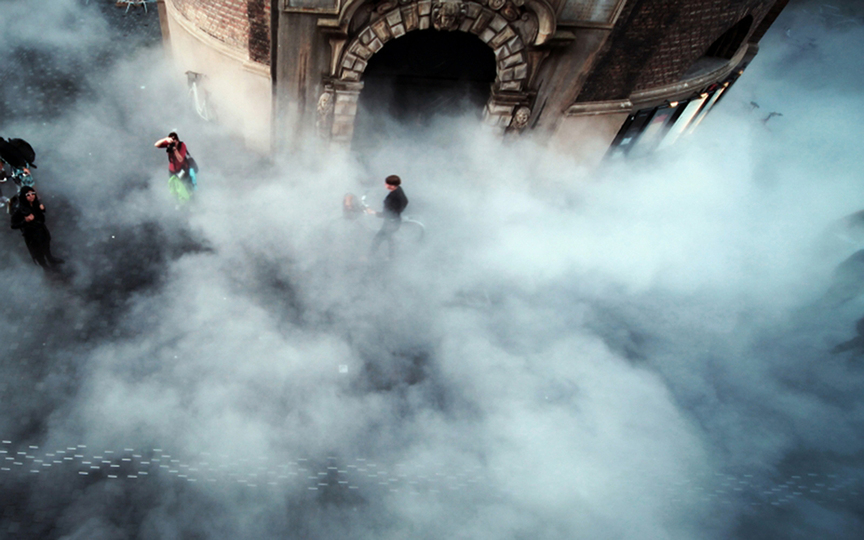-
From Current Issue
-
- Editor’s Letter Fire in the Heart
- Reviews I Gusti Ayu Kadek Murniasih
- Reviews 11th Seoul Mediacity Biennale: “One Escape at a Time”
- Dispatch Networked China
- One on One Monira Al Qadiri on Yukio Mishima
- Essays The rise of independent art spaces in pandemic-era Shanghai
- Features Tuan Andrew Nguyen
- Table of Contents
- Web Exclusives
- Archive
- Subscribe

R
E
V N
E
X
T
Fog is a peculiar substance. It combines two states of matter: gas and liquid. It physically visualizes the ever-present, invisible currents of air that surround the globe. It has the ability to render the sense that humans rely upon most heavily—sight—completely useless. Chinese artist Yuan Gong uses the amorphous nature of fog to provide a visual depiction of scent in his solo exhibition at Hong Kong’s Tang Contemporary Art, entitled “The Shape of Scent.” Embracing the dual nature of the Chinese word qì—which can be interpreted to mean “breath,” “vapor,” or “air,” as well as “energy” or “life force”—Yuan Gong evokes not only a sensory reaction within his viewers, but also a personal, almost spiritual feeling.
Comprised of nine works, six large oil paintings and three video pieces, the show gives the audience a rare opportunity to view some of the steps taken by an artist to realize their product. The videos, two of which are entitled Close to Heaven (2012) and the other Together (2011), document continuations of Yuan Gong’s previous work, The Scent of Air (2011), in which he invaded public areas with a dense, scented fog and filmed the reaction of the unsuspecting public. Upon first glance it may seem as though the presence of fog is the connection between the videos and the paintings; however, the connection is much more intimate. Yuan Gong used still frames of his various public interventions to capture the natural shape of the fog as incredibly detailed and regimented paintings.
Each of the large paintings from his “The Shape of Scent” series (all 2016) utilizes the aforementioned images of rolling vapor as a guide to create warped grids of dots in almost dizzying patterns. The Shape of Scent #7 depicts the most easily recognizable cloud of fog, somewhat reminiscent of an angry, gray storm cloud ready to burst. Rows of incredibly tiny, uniform dots—some dark, others an almost metallic silver—swirl inward from the outer edges of the painting, converging on the glowing yet ominous center of the cloud. Almost celestial, with light emanating from the interior of the fog, the spiritual aspects of qì intermingle with the artist’s intent to provide “scent” with a concrete form.
The other paintings are not as obviously vapor-inspired as The Shape of Scent #7. The Shape of Scent 5 boasts an unexpected orange hue, with a grid of swirling, cream-colored dots moving beneath patterns of much smaller bronze dots. The Shape of Scent #3 deviates from the other paintings by lacking a clear superimposition of the dots, which are usually layered one above the other and varying in size. The three different grids—composed of equally-sized dots in light blue, green and pink—build equally upon one another to not only provide the warped quality intrinsic to all of the works, but also to present shifting patterns hidden within the dots themselves.
Though certainly the least recognizable as a depiction of fog, the work with the most visual impact, The Shape of Scent #8, is the smallest one in the show, with a comparatively diminutive size of 110-by-150 centimeters. With stark, white dots superimposed on a dark black-gray background, the fabricated geometric field gathers and undulates in such a way that it creates an optical illusion of motion. Combine this already dizzying visual with the view overlooking Hong Kong from the gallery’s 19th-floor window, and the effect is downright vertigo inducing. Drawn in by sensory trickery, and upon closer inspection, viewers notice that what seemed from afar to be a grid of simple, solitary white dots is actually a combination of three different colors. Behind the white dots, incredibly hard to spot, is a second grid of dark green that does not follow the dizzying warping, but remains resolutely regimented and blends almost completely into the background. The third grid in the painting, composed of silver dots within the white—as though there are pearls affixed to the surface—not only provides a luminous quality to the work, but, when viewed from an angle, also creates a physical, three-dimensional texture.
By filling his canvases with hidden qualities that require viewers to overcome dizziness in order to observe them, Yuan has created works that not only draw in and engage with viewers, but also ones that stimulate strong physical reactions. Visitors to the exhibition embark upon a journey, beginning with footage of real-world interactions with mysterious fog and ending with surreal abstractions that epitomize the calm and confusion that is scent, vapor and qì.
Yuan Gong’s “The Shape of Scent” is on view at Tang Contemporary Art, Hong Kong, until August 27, 2016.







